| |||||
| Decades: | |||||
|---|---|---|---|---|---|
| See also: | |||||
Events from the year 1708 in Russia
| |||||
| Decades: | |||||
|---|---|---|---|---|---|
| See also: | |||||
Events from the year 1708 in Russia
| | This section needs expansion. You can help by adding to it. (July 2016) |
| | This section needs expansion. You can help by adding to it. (July 2016) |
| | This section needs expansion. You can help by adding to it. (July 2016) |

Ingria is a historical region in what is now northwestern European Russia. It lies along the southeastern shore of the Gulf of Finland, bordered by Lake Ladoga on the Karelian Isthmus in the north and by the River Narva on the border with Estonia in the west. The earliest known indigenous European peoples of the region are the now mostly Eastern Orthodox Izhorians and Votians, as well as the Ingrian Finns who descend from the Lutheran Finnish immigrants who settled in the area in the 17th century, when Finland proper and Ingria were both parts of the Swedish Empire.
A governorate, gubernia, province, or government was a major and principal administrative subdivision of the Russian Empire. After the Bolshevik Revolution in 1917, governorates remained as subdivisions in Belarus, Russia, Ukraine, and in the Soviet Union from its formation until 1929. The term is also translated as government, governorate, or province. A governorate was headed by a governor, a word borrowed from Latin gubernator, in turn from Greek κυβερνήτης.
The administrative division reform of 1708 was carried out by Russian Tsar Peter the Great in an attempt to improve the manageability of the vast territory of Russia. Prior to the reform, the country was subdivided into uyezds and volosts, and in the 17th century the number of the uyezds was 166.

The modern administrative-territorial structure of Russia is a system of territorial organization which is a product of a centuries-long evolution and reforms.
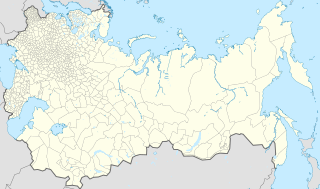
An uezd, or povit in a Ukrainian context, or Kreis in Baltic-German context, was a type of administrative subdivision of the Grand Duchy of Moscow, the Tsardom of Russia, the Russian Empire, the Russian SFSR, and the early Soviet Union, which was in use from the 13th century. For most of Russian history, uezds were a second-level administrative division. By sense, but not by etymology, uezd approximately corresponds to the English "county".
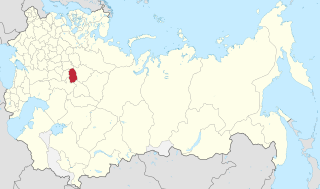
Kazan Governorate, also known as the Government of Kazan, was a governorate of the Tsardom of Russia, the Russian Empire, and the Russian SFSR from 1708 to 1920, with its seat in the city of Kazan.

Smolensk Governorate, or the Government of Smolensk, was an administrative division of the Tsardom of Russia, the Russian Empire, and the Russian SFSR. It existed, with interruptions, between 1708 and 1929.
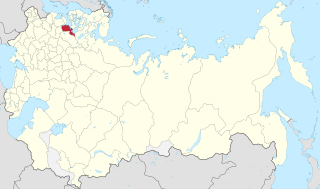
The Saint Petersburg Governorate was a governorate of the Russian Empire, with its administrative centre in Saint Petersburg. The governorate was composed of 44,613 square kilometres (17,225 sq mi) of area and 2,112,033 inhabitants. The Saint Petersburg Governorate was bordered by the Estonian and Livonian Governorates to the west, the Pskov Governorate to the south, the Novgorod Governorate to the east, the Olonets Governorate to the northeast, and the Vyborg Governorate of the Grand Duchy of Finland to the north. The governorate covered most of the areas of modern Leningrad Oblast and Ida-Viru, Jõgeva, Tartu, Põlva, and Võru counties of Estonia.
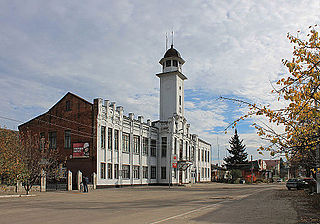
Lebedyn is a city in Sumy Oblast, Ukraine. Lebedyn is located in Sumy Raion. Before July 2020, Lebedyn served as the administrative center of Lebedyn Raion; it was administratively incorporated as a city of oblast significance and did not belong to the raion. Population: 23,892. An air base is located nearby. The city also has a railway station.


The Moscow Governorate was a province (guberniya) of the Tsardom of Russia, and later the Russian Empire. The governorate bordered by the Tver Governorate to the north, the Vladimir Governorate to the northeast, the Ryazan Governorate to the southeast, the Tula Governorate to the south, the Kaluga Governorate to the southwest, and the Smolensk Governorate to the west. The Moskow Governorate consisted of an area of 33,272.84 square kilometres (12,846.72 sq mi) and a population of 2,430,581 in 1897. The administrative centre was in the cultural capital of Moscow. The province covered most of Moscow Oblast.
Revel Governorate, also known as Tallinn Governorate, was an administrative division of the Russian Empire from 1719 to 1783.

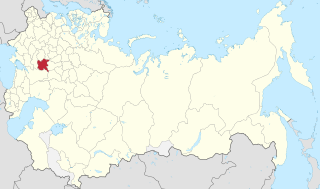

Kiev Governorate, or the Government of Kiev, was an administrative division of the Tsardom of Russia and then the Russian Empire. The government was established in December 1708 as one of the eight guberniyas first created during the reforms of Peter the Great.


The Nizhny Novgorod Governorate was an administrative division of the Russian Empire, Russian Republic, and the Russian SFSR, roughly corresponding to the Upper and Middle Volga region and what is now most of the Nizhny Novgorod Oblast. In the early of 20th Century, the Nizhny Novgorod Governorate bordered the Kostroma and Vyatka governorates to the north, the Vladimir Governorate to the west, the Kazan and Simbirsk governorates to the east, and the Penza and Tambov governorates to the south.

Korochansky Uyezd was one of the uyezds of Kursk Governorate of the Russian Empire and then of the Russian Soviet Federative Socialist Republic with its center in Korocha until its formal abolition in 1924 by Soviet authorities.
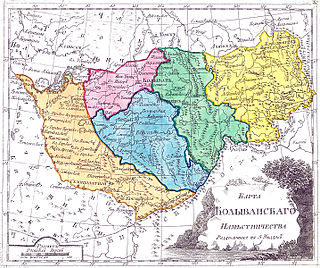
Kolyvan Viceroyalty - an administrative-territorial entity in the Russian Empire that existed in 1783–1796.
![]() Media related to 1708 in Russia at Wikimedia Commons
Media related to 1708 in Russia at Wikimedia Commons